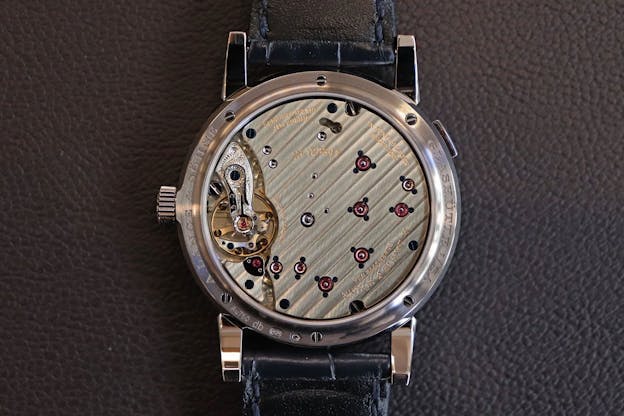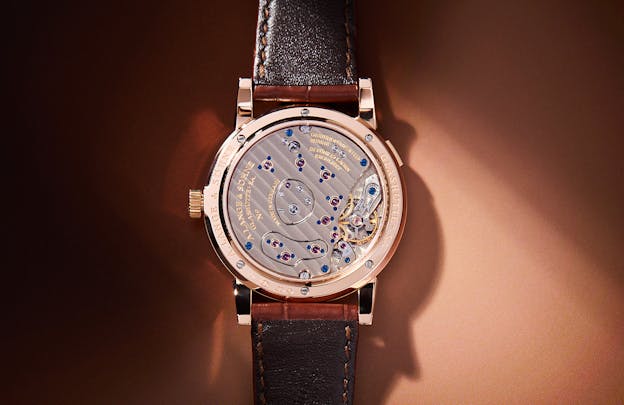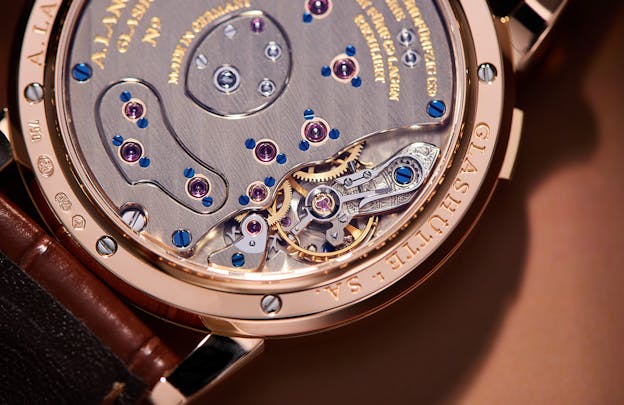An OG Lange 1 Ref. 101.032 In Pink Gold
The first incarnation of the Lange 1 was an exercise in both design innovation and technical ingenuity – and was the brainchild of three architects of the modern watch world.
There have been, since A. Lange & Söhne launched its first collections in 1994, two basic versions of the Lange 1, not including all the complications and special editions. The basic Lange 1, with its signature big date display and asymmetric but balanced dial design, has in terms of cosmetics and overall design, changed almost not at all since 1994 – there have been some very minute tweaks to the “Made In Germany” typeface and virtually invisible changes to the bezel, but the basic 38.5mm diameter watch (large for the time) you see today is almost exactly what you would have seen had you been in Dresden, on October 24th, 1994, when the official launch event was held. An interesting footnote to Lange’s history, and the launch of the Lange 1, is that, according to the comprehensive guide to the Lange 1 at Langepedia, the reason that all Lange big date displays in all of Lange’s watches are set to the 25th, from the beginning down to the present day, is because that was the date on which the world press would have run the story. (In 1994 the Internet was still in its infancy, although that was the year of the first International World Wide Web conference at CERN, the Internet’s birthplace – and print was still where just about everyone got their news).
The most recent version was launched in 2015, and while the newer version is to all intents and purposes identical to its predecessor, there was one major change made to the original, which was an update to the movement. This week, for A Watch A Week, we have an example of the original, first-ever Lange 1 movement, in a pink gold Lange 1 reference 101.032.

To understand why Lange decided to develop a new movement for the Lange 1, and launch it in 2015, after a very successful 21 year run with the original model, it helps to look at both the original Lange caliber L901.0 – which, by the way, is the movement used in this reference – and the new version, introduced in 2015.

Above is the newer version of the Lange 1 caliber, introduced in 2015; this is the caliber L121.1. The movement is classic Lange in many respects. The 3/4 plate is in German silver (which is actually a nickel-zinc alloy, and contains no silver at all; it’s called maillechort in French) with chatons for the jewels for the upper train pivots. (Assembling a 3/4 plate movement is more difficult than assembling a conventional full bridge movement, as you have to get all the pivots to fall into their jewels at the same time, although it is at least theoretically, a more rigid construction, as well as expressing the approach that Lange took in the construction of its pocket watches). The balance is freesprung, with eccentric timing weights and the swan’s neck regulator is there to adjust the balance spring stud (its outer attachment point) so that the balance is “in beat” (that is, so that the difference between the amount of time it takes the balance to swing clockwise vs. swing anticlockwise, is zero).
You’ll notice that the crown is right next to the balance. The 3/4 plate presents an essentially unbroken surface, and is decorated with “Glashütte stripes.” And of course, you have the hand-engraved balance cock, which has been a Lange signature from the beginning.
Now let’s look at the earlier version of the Lange 1 caliber – L901.1.

You’ll immediately notice that the L901.1 presents a much more complex appearance. The most obvious difference between the older and the newer movements is in the position of the balance cock relative to the crown – in the L901.1, aka the Original Gangster Lange Caliber, the balance is on the opposite side of the movement from the crown. The escape wheel is under a separate, smaller cock, under the balance, with the fourth wheel, which turns once per minute, just above it. The swan’s neck regulator here is used to adjust the rate of the watch rather than the beat (that is, it’s used to fine-tune accuracy to keep the watch from running too fast or too slow) and the movement uses the regulator pins to adjust rate, rather than the timing weights used in the newer version.
There are several interesting workarounds in the design. Normally, the seconds hand of a watch is fitted onto the pivot of the movement fourth wheel, and in a traditional, non-center seconds watch, the fourth wheel is at 6:00 on the dial side, which is why just about every pocket watch ever made has a small seconds subdial at 6:00. In the Lange I caliber L901.1, however, the fourth wheel’s in the wrong place relative to the seconds subdial, and so Lange used a set of intermediate wheels to get power over to the other side of the movement, and drive the seconds hand. Those intermediate wheels are under the elongated insert in the movement, at 6:00 in the image above. This means that unlike the newer L121.1 caliber, the original L901.1 has an indirectly driven center seconds. All other things being equal, it’s better to have a seconds hand that’s directly driven and one of the big mandates for the Lange design team for the L121.1, was reconfiguring the gear train to support a directly driven center seconds.
You might be wondering what’s in the other insert in the mainplate – that’s where you’ll find the keyless works, for winding and setting. Thanks to the position of the subdial for the hours and minutes, the keyless works have to be in the center of the movement; that’s where they are in the newer L121.1 as well, but sans insert.

Now, the question is, why is the L901.1 set up in the way that it is? Part of the answer has to do with the design of the watch itself – the positions of the sub-dials on the dial side, as well as the power reserve indicator. Another reason has to do with one of the two main personalities behind the rebirth of Lange. One of them of course was Walter Lange, but the other was a Nuremberg-born businessman named Günter Blümlein, who though less well known than, say Nicholas Hayek, was nonetheless one of the essential architects of the modern watch world.
Blümlein was responsible for managing both IWC and Jaeger-LeCoultre during the time that they were part of a group called Les Manufactures Horlogères, which was in turn held by a firm called VDO Schindling AG. (The whole story is a complicated one but worth familiarizing yourself with if you don’t know the main points; for one thing, it illustrates both the complex interrelationships between various watch brands and the rapidity with which the modern watch landscape evolved). For the first Lange 1 caliber L901.1, Blümlein and watchmaker Reinhard Meis, one of the main architects of Lange’s first generation of movements (and the author of the incredibly comprehensive Das Tourbillon, which is nothing less than a survey of pretty much every tourbillon known, right up to the 1990s, and which has frustratingly never been translated into English) decided to use the gear train from a movement made by Jaeger-LeCoultre – the Jaeger-LeCoultre caliber 822.

The Lange 1 reference 101.032 was first introduced by Lange in 1998. It has been replaced in the current Lange catalog by the reference 191.032. Purely on technical merits I think it is pretty clear that the newer movement is better in several key respects (although I would not want to be the watchmaker that has to get all those pivots into the 3/4 plate at once). On top of the other key advantages of the L121.1 already mentioned, it has an instantaneous switching big date display, which the L901.1 doesn’t .

But the reference 101.032, and the Lange caliber L901.1, represent a remarkable part of a remarkable story. The architecture of the original L901.1 caliber is an expression of will, determination and ingenuity from three men especially who were at the forefront of Lange’s rebirth – Walter Lange, Günter Blümlein, and Reinhard Meis – without whom the story of modern watchmaking would be very different, and without whom we would almost certainly not have the Lange 1 at all. All three gentlemen have passed away – Günter Blümlein died young, and unexpectedly, at the age of just 58, in 2001; Walter Lange would later say, “Without Günter Blümlein, A. Lange & Söhne would no longer exist – and Glashütte would not again be the centre of German precision watchmaking today.” Walter Lange died in 2017 at the age of 92, and Reinhard Meis, only last year, in January of 2023, at the age of 83. I met Walter Lange on a few occasions; never had a chance to meet Blümlein; I had always meant to write to Meis expressing my admiration of Das Tourbillon, but never did, which is a lesson to remember to send flowers to the living while you can.
But their partnership and the excitement and creativity of that era of watchmaking is still alive in the 101.032 and the caliber L901.1. The watch and the movement inside it represent what I have always thought is maybe the most important and meaningful part of watch collecting – that fine watchmaking connects us to people, who, even though they might no longer be with us (and in fact mostly are not; watchmaking in Europe has been going on for five hundred years, more or less) can still touch us, when we touch their work.

